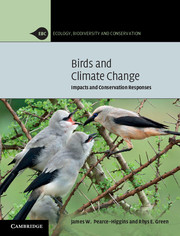Book contents
2 - Altered timings
Published online by Cambridge University Press: 05 June 2014
Summary
What is phenology and why does it matter?
We are all familiar with the changing seasons of the natural world around us.
At medium and high latitudes, spring is characterised by budburst, leaf growth and the flowering of many plants, the arrival of long-distance migrants and breeding of most bird species, and the emergence of adult stages of many insects. Autumn is signalled by the departure of long-distance migrants and leaf fall of deciduous plants. In both freshwater and marine environments, spring warming stimulates first phytoplankton and then zooplankton blooms which provide food for higher predators, influencing the timing of fish and bird breeding seasons. In the humid tropics, where temperature regimes vary less throughout the year, seasonality is often determined by predictable variation in rainfall, which then stimulates a flush in plant growth, flowering and fruiting, animal emergence and breeding. In the dry tropics, many organisms adjust their life cycles to the unpredictable arrival of rains or fires, which then lead to a pulse of growth and biological activity. Phenology is the study of the timing of these events.
- Type
- Chapter
- Information
- Birds and Climate ChangeImpacts and Conservation Responses, pp. 25 - 62Publisher: Cambridge University PressPrint publication year: 2014
- 1
- Cited by



